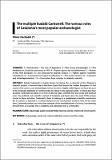Por favor, use este identificador para citar o enlazar a este item:
http://hdl.handle.net/10261/86856COMPARTIR / EXPORTAR:
 SHARE
BASE SHARE
BASE
|
|
| Visualizar otros formatos: MARC | Dublin Core | RDF | ORE | MODS | METS | DIDL | DATACITE | |

| Campo DC | Valor | Lengua/Idioma |
|---|---|---|
| dc.contributor.author | Hochadel, Oliver | - |
| dc.date.accessioned | 2013-11-18T07:29:39Z | - |
| dc.date.available | 2013-11-18T07:29:39Z | - |
| dc.date.issued | 2013 | - |
| dc.identifier.citation | Dynamis (33/2): 389-416 (2013) | es_ES |
| dc.identifier.issn | 0211-9536 | - |
| dc.identifier.uri | http://hdl.handle.net/10261/86856 | - |
| dc.description.abstract | [EN] Eudald Carbonell is mainly known for being the co-director of the Atapuerca research project, a hominid site in Northern Spain that boasts the «oldest European». In the course of his career as an archaeologist, he has become a highly visible figure, not least because of his incessant attempts to communicate his ideas to the general public. In these past four decades, Carbonell has taken on a host of diverse roles: scientific but also social and political ones. The political and scientific context of Catalonia and Spain since the early 1970s proves crucial in these activities. Carbonell’s claim to belong to a «peripheral» scientific community (be it Catalan or Spanish) is a central element in the construction of these roles. At the same time, Carbonell provides an instructive example of the «medialization» of science, transforming himself from an outsider into a celebrity and ultimately into a commodity | es_ES |
| dc.description.abstract | [ES] Eudald Carbonell es conocido principalmente por ser el co-director del proyecto de investigación de Atapuerca, un enclave de homínidos en el norte de España que cuenta con el «europeo más antiguo». En el curso de su carrera como arqueólogo, se ha convertido en una figura muy visible, sobre todo debido a sus incesantes intentos de comunicar sus ideas al público en general. En estas últimas cuatro décadas, Carbonell ha adquirido una gran cantidad de diversos roles: No sólo científico, sino también social y político. El contexto político y científico de Cataluña y España desde principios de 1970 resulta crucial en estas actividades. La afirmación de Carbonell pertenecer a una «periférica» comunidad científica (ya sea como catalán o español) es un elemento central en la construcción de estos roles. Al mismo tiempo, Carbonell es un ejemplo ilustrativo de la «medialización» de la ciencia, transformándose de un extraño en una celebridad y en última instancia en una mercancía | es_ES |
| dc.language.iso | eng | es_ES |
| dc.publisher | Universidad de Granada | es_ES |
| dc.publisher | Universidad Miguel Hernández de Elche | - |
| dc.publisher | Universidad Autónoma de Barcelona | - |
| dc.publisher | Universidad de Cantabria | - |
| dc.rights | openAccess | es_ES |
| dc.subject | Archaeology | es_ES |
| dc.subject | Social role | es_ES |
| dc.subject | National identity | es_ES |
| dc.subject | Science and the media | es_ES |
| dc.subject | Arqueología | es_ES |
| dc.subject | Papel social | es_ES |
| dc.subject | Identidad nacional | es_ES |
| dc.subject | Ciencia y medios de comunicación | es_ES |
| dc.title | The multiple Eudald Carbonell: the various roles of Catalonia’s most popular archaeologist | es_ES |
| dc.type | artículo | es_ES |
| dc.description.peerreviewed | Peer reviewed | es_ES |
| dc.relation.publisherversion | http://www.raco.cat/index.php/Dynamis/article/view/269168/356736 | es_ES |
| dc.identifier.e-issn | 2340-7948 | - |
| dc.rights.license | Este obra está bajo una licencia de Creative Commons Reconocimiento-NoComercial-SinObraDerivada 3.0 Unported | - |
| dc.type.coar | http://purl.org/coar/resource_type/c_6501 | es_ES |
| item.cerifentitytype | Publications | - |
| item.openairecristype | http://purl.org/coar/resource_type/c_18cf | - |
| item.grantfulltext | open | - |
| item.openairetype | artículo | - |
| item.fulltext | With Fulltext | - |
| item.languageiso639-1 | en | - |
| Aparece en las colecciones: | (IMF) Artículos | |
Ficheros en este ítem:
| Fichero | Descripción | Tamaño | Formato | |
|---|---|---|---|---|
| Hochadel-2013-The multiple Eudald Carbonell---The various roles.pdf | 322,82 kB | Adobe PDF |  Visualizar/Abrir |
CORE Recommender
Page view(s)
314
checked on 02-may-2024
Download(s)
223
checked on 02-may-2024
Google ScholarTM
Check
NOTA: Los ítems de Digital.CSIC están protegidos por copyright, con todos los derechos reservados, a menos que se indique lo contrario.
